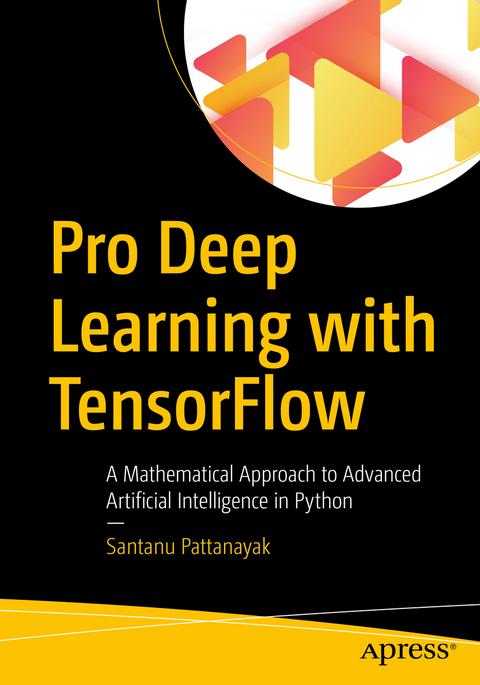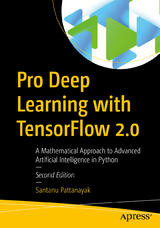
Pro Deep Learning with TensorFlow
Apress (Verlag)
978-1-4842-3095-4 (ISBN)
- Titel erscheint in neuer Auflage
- Artikel merken
Pro Deep Learning with TensorFlow provides practical, hands-on expertise so you can learn deep learning from scratch and deploy meaningful deep learning solutions. This book will allow you to get up to speed quickly using TensorFlow and to optimize different deep learning architectures.
All of the practical aspects of deep learning that are relevant in any industry are emphasized in this book. You will be able to use the prototypes demonstrated to build new deep learning applications. The code presented in the book is available in the form of iPython notebooks and scripts which allow you to try out examples and extend them in interesting ways.
You will be equipped with the mathematical foundation and scientific knowledge to pursue research in this field and give back to the community.
What You'll Learn
Understand full stack deep learning using TensorFlow and gain a solid mathematical foundation for deep learning
Deploy complex deep learning solutions in production using TensorFlow
Carry out research on deep learning and perform experiments using TensorFlow
Who This Book Is For
Data scientists and machine learning professionals, software developers, graduate students, and open source enthusiasts
Santanu Pattanayak currently works at GE, Digital as a Senior Data Scientist. He has 10 years of overall work experience with six of years of experience in the data analytics/data science field and also has a background in development and database technologies. Prior to joining GE, Santanu worked in companies such as RBS, Capgemini, and IBM. He graduated with a degree in electrical engineering from Jadavpur University, Kolkata and is an avid math enthusiast. Santanu is currently pursuing a master's degree in data science from Indian Institute of Technology (IIT), Hyderabad. He also devotes his time to data science hackathons and Kaggle competitions where he ranks within the top 500 across the globe. Santanu was born and brought up in West Bengal, India and currently resides in Bangalore, India with his wife.
Chapter 1: Machine Learning Basics and Mathematical Foundation for Deep Learning Chapter Goal: Introduce Machine Learning basics and Mathematical Foundations that are associated with Deep Learning No of pages 70-90Sub-Topics1. Linear Algebra basics.2. Numerical Stability and Conditioning.3. Probability.4. Different types of cost functions and introduction to least squares and maximum likelihood methods.5. Convex and Non-convex function 6. Optimization Techniques such as Gradient Descent and Stochastic Gradient Descent as well as Constrained Optimization problems.7. Regularization and Early stopping8. Auto Differentiators and Symbolic Differentiators.
Chapter 2: Introduction to Deep Learning Concepts and TensorFlow Chapter Goal: Introduce Deep Learning concepts and its comparison with previous Neural Networks. Reasons for its success and computational efficiency and a start to TensorFlow Development.No of pages 60-70Sub -Topics 1. Previous Neural Networks and their shortcomings 2. Introduction to Deep Learning Framework and its advantages.3. Why TensorFlow for Deep Learning and its comparison with other Deep Learning Frameworks like Theano, Caffe, Torch, etc.4. Hands on in TensorFlow development environment and introduction to Dynamic Computation graphs. 5. Linear and Logistic regression in a TensorFlow environment6. Feed forward networks through TensorFlow.7. Leveraging GPUs for Computational efficiency.
Chapter 3: Image and Audio Processing in TensorFlow through Convolutional Neural Networks Chapter Goal: Learn to process image and audio data to solve classification, clustering, and recommendation problems using Convolutional Neural Network. No of pages: 70-80Sub - Topics: 1. Convolution and Image processing through Convolution.2. Different Kinds of Image processing filters like Guassian Filter, Sobel Filter, Canny’s edge detection filter.3. Different Layers of Convolutional Neural Network – Convolution layer, Pooling Layers, activation layers using RELUs, Dropout layers and fully connected layer. Intuition of features learned in Different layers. Concepts of strides, padding and kernels.4. Solving image classification, clustering and recommendation problems through Convolutional Neural network.5. Feature transfer in Convolutional Neural Network.6. Audio classification problems through Convolutional Neural networks.
Chapter 4: Restricted Boltzmann Deep Learning Architectures through TensorFlow for Various ProblemsChapter Goal: Leverage Restricted Boltzmann Machines (RBMs) for solving Recommendation problems, weight initialization in Deep Learning Networks and for Layer by Layer training of Deep Neural Networks.No of pages:50-60Sub - Topics: 1. Introduction to Restricted Boltzmann Machines (RBMs) and its architecture.2. Using RBMs to build Recommendation engines.3. RBMs for smart weight initialization of Deep Learning Networks.4. Train complex deep learning networks layer by layer (one layer at a time) through RBMs
Chapter 5: Deep Learning for Natural Language Processing through TensorFlow Chapter Goal: Leverage TensorFlow Deep learning capabilities for Natural Language processing No of pages: 50-601. Text processing basics such as Word2Vec Representation, Semantic and Syntactic Analysis. 2. Recurrent Neural network(RNNs) for language modelling through TensorFlow3. Backpropagation through time and problems of Vanishing and Exploding gradients.4. Gradient Clipping and LSTM (Long Short-Term Memory) to overcome Exploding and Vanishing gradient problems.5. Applications of RNN in generating sequences and words.
Chapter 6: Unsupervised Learning in TensorFlow through Autoencoders Chapter Goal: Leverage Autoencoders for doing Unsupervised Learning No of pages: 30-401. Data Compression through Autoencoders.2. Feature Learning through Auto Encoders.3. A comparison of feature learning through PCA and Stacked Auto Encoders.
| Erscheinungsdatum | 06.01.2018 |
|---|---|
| Zusatzinfo | 87 Illustrations, color; 102 Illustrations, black and white; XXI, 398 p. 189 illus., 87 illus. in color. |
| Verlagsort | Berkley |
| Sprache | englisch |
| Maße | 178 x 254 mm |
| Gewicht | 7917 g |
| Themenwelt | Mathematik / Informatik ► Informatik ► Datenbanken |
| Mathematik / Informatik ► Informatik ► Programmiersprachen / -werkzeuge | |
| Mathematik / Informatik ► Informatik ► Software Entwicklung | |
| Informatik ► Theorie / Studium ► Künstliche Intelligenz / Robotik | |
| Schlagworte | audio processing • Autoencoders • Boltzmann Deep Learning Architectures • convolutional neural networks • Deep learning • Image Processing • IPython • machine learning • Natural Language Processing • Python • tensorflow |
| ISBN-10 | 1-4842-3095-7 / 1484230957 |
| ISBN-13 | 978-1-4842-3095-4 / 9781484230954 |
| Zustand | Neuware |
| Informationen gemäß Produktsicherheitsverordnung (GPSR) | |
| Haben Sie eine Frage zum Produkt? |
aus dem Bereich



